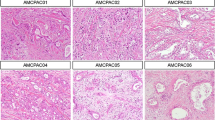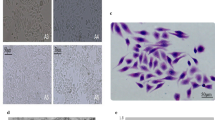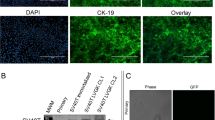Summary
From a liver metastasis of a human pancreatic adenocarcinoma, we have established cell lines for studying the cell biology of this tumor. We obtained two cell lines with different morphological, chromosomal and functional properties. One of them, named PaTu 8988s, revealed a solid growth in nude mouse xenografts with cells exhibiting only occasional polar organisation of the cytoplasm. In general, no apical or basolateral plasma membrane domains could be distinguished and the sparse organelles were randomly distributed throughout the cytoplasm. Secretory products, such as mucin, were weakly stained histochemically or were completely absent. Transglutaminase (TGase) activity used as a marker for cellular differentiation was low in these cells. The other cell line, named PaTu 8988t, grew tumors composed of tubular structures when injected subcutaneously into nude mice. Cells were polarized with distinct apical and basolateral plasma membranes and the cytoplasmatic organelles were arranged with the nucleus in the lower part of the cell, while the apical cytoplasm contained the Golgi complex and numerous secretion granules. A high content of mucin was stained histochemically and transglutaminase activity was ten times higher than in PaTu 8988s. Comparing the chromosome number per metaphase plate, both cell lines showed a major peak, with 45–55 chromosomes per metaphase plate in PaTu 8988s and about 110–120 chromosomes per metaphase plate in PaTu 8988t. When the two cell lines were injected intraveneously into the tail vein of nude mice, only PaTu 8988s developed metastases localized exclusively in the lung, whereas PaTu 8988t produced no metastases in any organ. We conclude, that two cell lines exhibiting different grades of differentiation as well as a different potency to metastasize can be established from the same primary tumor, and that these cell lines represent a suitable model for further study of the cell biology of human pancreatic adenocarcinoma.
Similar content being viewed by others
References
Birckbichler PJ, Patterson MK (1977) Cellular transglutaminase, growth and transformation. Ann NY Acad Sci 312:354–365
Birckbichler PJ, Orr GR, Conway E, Patterson MK (1978) Transglutaminase activity in normal and transformed cells. Cancer Res 37:1340–1344
Delcros JG, Bard S, Roch AM, Quash G, Poupon MF, Korach S (1986) Transglutaminase activity and putrescine-binding capacity in cloned cell lines with different metastatic potential. FEBS Lett 196:325–330
Elsässer HP, Klöppel G, Mannherz HG, Flocke K, Kern HF (1991) Immunohistochemical demonstration of villin in the normal human pancreas and in chronic pancreatitis. Histochem 95:383–390
Folk JE (1980) Transglutaminases Ann Rev Biochem 49:517–531
Kern HF, Röher HD, von Bülow M, Klöppel G (1987) Fine structure of three major grades of malignancy of human pancreatic adenocarcinoma. Pancreas 2:2–13
Kim YW, Kern HF, Mullins TD, Koriwchak MJ, Metzgar RS (1989) Characterisation of clones of a human pancreatic adenocarcinoma cell line representing different stages of differentiation. Pancreas 4:353–362
Klöppel G, Fitzgerald PJ (1986) Pathology of nonendocrine pancreatic tumors. In: Go VLW, Gardner JD, Brooks FP, Lebenthal E, DiMagno EP, Scheele GA (eds) The exocrine pancreas. Raven Press, New York, pp 649–674
Klöppel G, Lingenthal G, von Bülow M, Kern HF (1985) Histological and fine structural features of pancreatic ductal adenocarcinomas in relation to growth and prognosis. Studies in xenografted tumors and clinicohistopathologic correlation in a series of 75 cases. Histopathology 9:841–856
Lowry OH, Rosebrough NJ, Farr AL, Randall RJ (1951) Protein measurement with the Folin phenol reagent. J Biol Chem 193:265–275
Matsuzaki M, Natori T, Mizumoto K, Kitazawa S, Tsutsumi M, Konishi Y (1989) Intracellular distribution of pancreatic tumor antigen purified from BHP-induced adenocarcinoma in Syrian hamsters. Pancreas 4:429–435
McIntyre LJ, Itzkowitz SH, Kim YS (1986) Human pancreatic cancer cell lines. In: Webber MM (ed) In Vitro models in cancer research, vol II. Carcinomas of the liver and the pancreas. CRC Press, Boca Raton, pp 153–195
Nowell P (1976) The clonal evolution of tumor cell populations. Science 194:23–28
Palombella VJ, Mendelsohn J, Vilcek J (1988) Mitogenic action of tumor necrosis factor in human fibroblasts: interaction with epidermal growth factor and platelet-derived growth factor. J Cell Physiol 135:23–31
Pardue ML (1991) Dynamic instability of chromosomes and genomes. Cell 66:427–431
Piacentini M, Sartori C, Beninati S, Bargagli AM, Argento-Ceru MP (1986) Ornithine decarboxylase, transglutaminase, diamine oxidase and total diamine and polyamines in maternal liver and kidney throughout rat pregnancy. Biochem J 234:435–440
Scarpelli DG, Rao MS (1978) Pathogenesis of pancreatic carcinoma in hamsters induced by N-nitrosobis(2-oxopropyl)amine (BOP). Fed Proc 37:231
Scarpelli DG, Rao MS, Reddy JK (1984) Studies of pancreatic carcinogenesis in different animal models. Environmental Health Perspect 56:219–227
Takiyama Y, Egami H, Pour PM (1990) Expression of human tumor-associated antigens in pancreatic cancer induced in Syrian hamsters. Am J Pathol 136:707–715
Vega-Salas DE, Salas PJI, Rodriguez-Boulan E (1988) Exocytosis of vacuolar apical compartment (VAC): a cell-cell contact controlled mechanism for the establishment of the apical plasma membrane domain in epithelial cells. J Cell Biol 107:1717–1728
Author information
Authors and Affiliations
Rights and permissions
About this article
Cite this article
Elsässer, HP., Lehr, U., Agricola, B. et al. Establishment and characterisation of two cell lines with different grade of differentiation derived from one primary human pancreatic adenocarcinoma. Virchows Archiv B Cell Pathol 61, 295–306 (1992). https://doi.org/10.1007/BF02890431
Received:
Accepted:
Issue Date:
DOI: https://doi.org/10.1007/BF02890431




